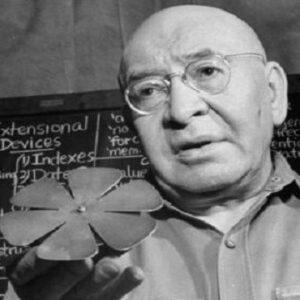Alfred Habdank Skarbek Korzybski was a Polish American scholar who is credited with creating the field of general semantics. General Semantics, which is not the same thing as the field of semantics, is a program that tries to control how the brain evaluates things. Korzybski had always been interested in the complexity of the human brain. He thought that human knowledge is limited not only by the nervous system, but also by the languages that humans have made. This means that no human can know the absolute truth. He was an engineer by trade, and he was very good at noticing how people act. He found it most interesting that, despite all the progress people have made in math, science, and technology, they still don’t know how their own brains work. So, he spent a lot of time studying how people act. His work led to the development of what became known as general semantics. Soon, this field was seen as a science and was taught in colleges and universities. He is most famous for saying, “The map is not the territory,” which means that the real thing is different from how it is shown.
Early years and childhood
He was born in Warsaw, Poland, on July 3, 1879, into an aristocratic family that had mathematicians, scientists, and engineers in it for many generations.
His parents had a lot of money, so they made sure he got the best education possible. At home, he learned Polish. At school, he learned Russian. His governesses taught him, French and German. When he was a teen, he could speak all four of these languages well.
Before going to Warsaw University of Technology to study engineering, he ran his father’s farm for a while.
Alfred Korzybski’s Career
When World War I started, he joined the Second Russian Army as a volunteer and worked as an intelligence officer in the General Staff Intelligence Department.
During his service, his horse was shot out from under him, which hurt his hip. He also hurt his leg badly and had injuries inside of him.
In December 1915, he was sent to Canada’s Camp Petawawa testing grounds to watch new artillery tests. Then he moved to the United States to help plan how artillery would get to Russia. There, he also helped the US government by getting the word out about the sale of war bonds.
After the Russian army fell apart during the Russian Revolution of 1917, he joined the French-Polish army.
After the war, he chose to stay in the United States. He changed a lot because of what he went through in the war. He didn’t understand why people did so much killing and violence for no reason. This made him look at the differences between how people and animals act and study those differences.
His friends, the biologist Jacques Loeb and the mathematician Cassius Jackson Keyser, were impressed by his ideas and told him to publish them. In 1921, Korzybski’s book “Manhood of Humanity: The Science and Art of Human Engineering,” which he wrote because he wanted to, came out.
His first book did well, so he kept looking into things. By this time, psychiatry was one of his areas of research, and he spent two years learning from William Alanson White, who was in charge of the St. Elizabeth’s Hospital in Washington, D.C.
In 1923, he tried to get a U.S. patent for his Structural Differential model. He had also been working on a concept he called “Time-binding” for the past few years. In 1924, he put out a book called “Time-Binding: The General Theory” and gave a talk about it at the International Mathematical Congress in Toronto.
In October 1933, he wrote a book called “Science and Sanity: An Introduction to Non-Aristotelian Systems and General Semantics.”
By this time, he was very well-known. From 1934 to 1937, he gave lectures and seminars all over the country based on the method of “General Semantics,” which he had written about in the book “Science and Sanity.”
In 1938, he started the Institute of General Semantics in Chicago. The first money came from Cornelius Crane in Chicago and Frances Stone Dewing in Massachusetts. M. Kendig was the first person in charge of the Institute’s education.
After World War II, he moved the institute to Lakeville, Connecticut, in 1946. He was in charge of the institute until he died. In 1951, “Perception: An Approach to Personality” included a chapter of his last paper, “The Role of Language in the Perceptual Processes.”
Works of note
He is best known for creating the field of general semantics, which looks at language from a philosophical point of view. It tries to figure out the relationship between how language looks and how it is used. It also tries to control how people can express themselves.
Personal Life & legacy
In the late 1910s, he met Mira Edgerly, who was a good portrait painter. They got married in 1919. The two stayed together until he died.
He had always been a busy person, and his busy life started to hurt his health in his later years. On March 1, 1950, he died from a blood clot in his heart.
Estimated Nt worth
Alfred Korzybski’s estimated net worth is $8 million, and his main income comes from being an engineer, philosopher, linguist, and mathematician. We don’t know enough about Alfred Korzybski’s cars or about his lifestyle.


